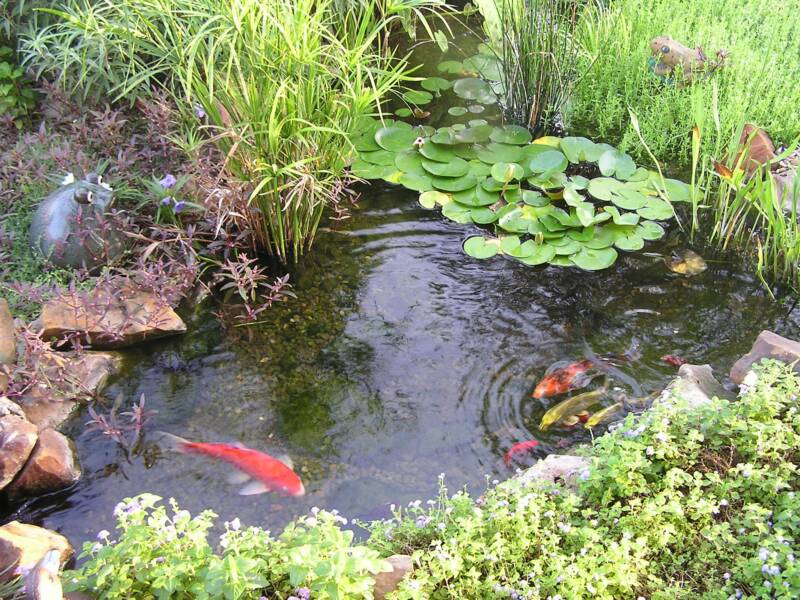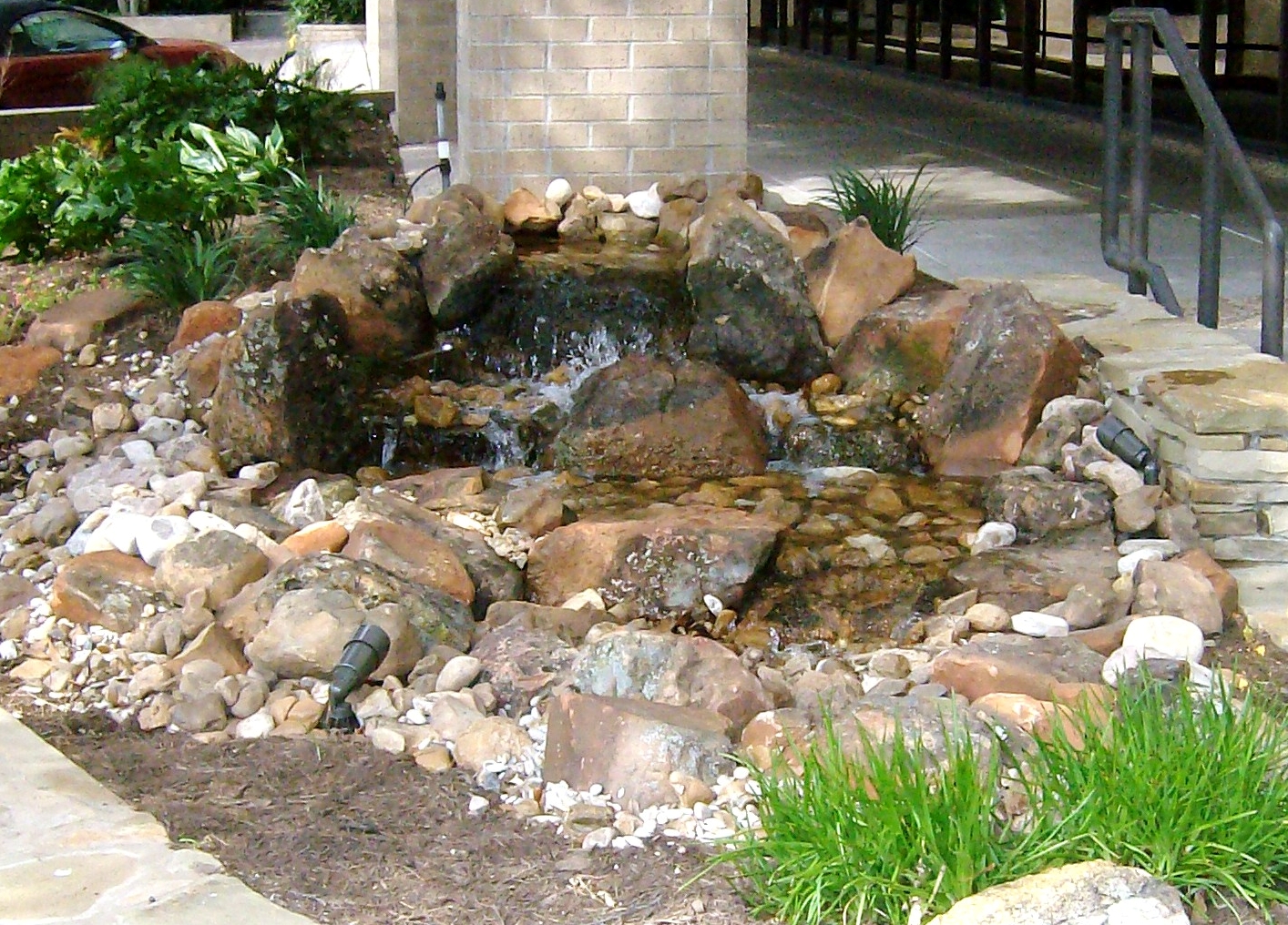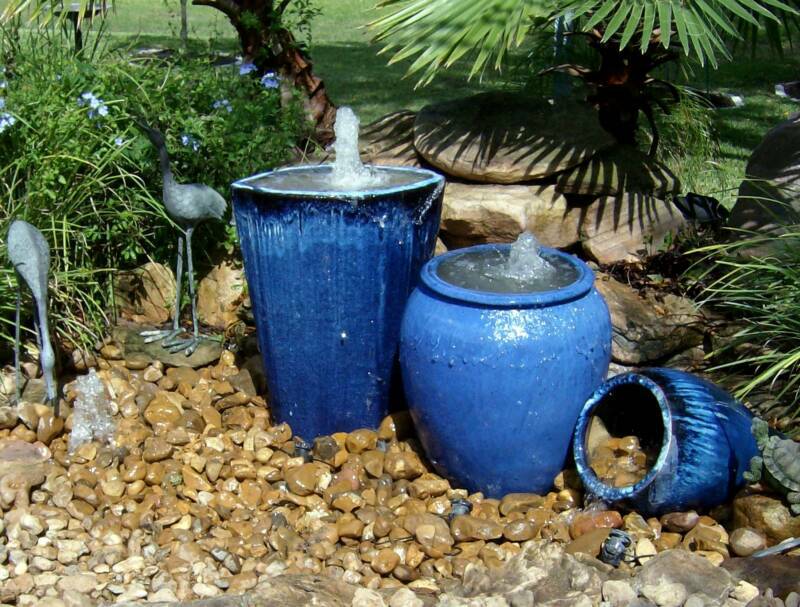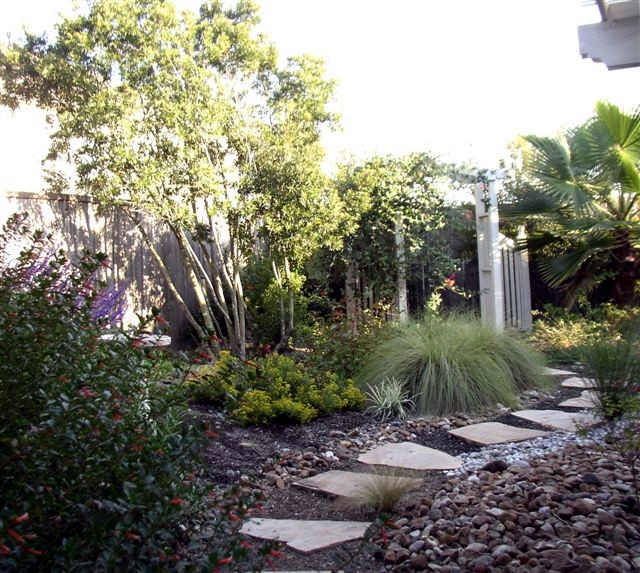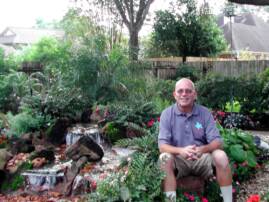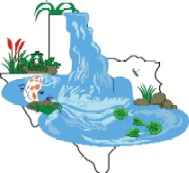


Rainwater Harvesting
Organic Ecosystem Ponds
Pondless Waterfalls
Urn and Fountain Features
Water-Wise Landscapes
Meet Your Water Feature Professionals


Texas Ponds and
Water Features
How ‘Bout A Backyard Wildlife Habitat?
by Matt Boring
‘The Natural Water Gardener’
As I stay home and wait out the Ice Storm of 2007, I’m trying to think warm thoughts and try not to leave the house for a couple of days at least. With a few days stuck at home, people can relax, drink some cocoa, and put a little extra time into planning their landscape projects for the coming year. In this time of undeniable climate change, many of us are thinking more about how to reduce the size of our ‘footprints’ on the natural world. Since most of us live in suburbia now, it’s not like the average person can go out and put up a giant windmill to generate clean electricity, but there things you can do on a smaller scale to make a difference. If enough people start thinking, and more importantly, acting along these lines, it can spread out like ripples in a pond, and change the next generation’s attitude about the fragility of the natural world.
You can see the beginning of the future in the wind farms in California and West Texas. The hybrid cars that drive alongside us in traffic, and soon the plug-in electric cars whose gasoline motor will only generate electricity for the electric motor, then even hydrogen fuel-cell cars that don’t pollute at all will be in our garages. More people are starting to recycle and to landscape and garden and even eat organically. Many cities are revitalizing their urban cores with walkable, liveable downtown areas where residents can live, work, and play without the need for a car in their daily routines. It’s exciting to watch things unfold as people and new technologies help us build a tomorrow that is more appreciative and respectful of the natural world around us.
The Natural Resource Conservation Service also promotes the Backyard Wildlife Habitat program to encourage people to plan their properties in such a way that the natural species that were most likely living in that area before it was cleared to make a subdivision are given back a piece of the habitat that was taken from them. The idea behind this plan is to encourage not only using plants native to the area you’re in, but also plants that provide shelter and food, such as Pyrocantha or other berrying plants. An organically-functioning water garden will not only create an ecosystem within and around itself, it will also invite many different bird species to drink and splash around in the waterfalls and shallow areas. Even a small yard can have big possibilities as long as you don’t think of your space as flat. It’s a three-dimensional space that includes everything from the bottom of the pond to the tops of the trees. Visit their website to learn more about planning and implementing a Backyard Wildlife Habitat. They also have tips for encouraging nature without inviting mice, etc.
Although most of my pond customers go organic and many have had some great yards for bird watching, none has gone to the point of getting their backyard actually certified as a Backyard Wildlife Habitat until I met Martha last year. I knew which house it was as soon as I turned onto her street in Pearland TX. There was not a bit of turf in her front yard. The whole yard was trees, plants, and flowers, everything nicely spaced, weeded, and neatly arranged with the plants’ mature size taken into consideration. This way the plants are allowed to take on more of what their natural shape is so they look better with minimal pruning. I’ve always thought it stupid to plant a shrub that wants to be ten feet tall into a space where you want a three foot tall shrub, then have to go in and butcher the plant 4-6 times a year to keep it that size. It deprives the plant of whatever natural beauty it had and by doing so, it says that shrub selection is not important— you’re just gonna hack it into the shape you want anyway. It’s got a kind weird man vs. nature vibe to it.
Martha had her backyard certified as a wildlife habitat before I met her, but she wanted a bigger source of water for the birds that visited her hard. We put in a nice little pond with a waterfall to provide a nice soothing sound when she sits out on the patio and positioned it so that she could watch it out the window when she was in the house. Recently I went back to check on things and was so impressed by the way everything had come together that I asked her if she wouldn’t mind writing a couple of sentences about her experiences with the Backyard Wildlife Habitat. I figured I could take those sentences and try to fashion an entertaining article around them, but when I read her words I knew I wanted to leave them just the way she wrote them. She has quite a nice writing style. She’s also included her e-mail address so that you can ask questions about her experiences. I used it to write and encourage her to keep writing. You can let her know what you think.
Backyard Habitat
It is a modest 30'x60' backyard in suburbia but rick with living creatures from denizens of the soil, pond dwellers, jumping, creeping, crawling and flying inhabitants. For five years it has been guided by an organic philosophy and a desire to be part of the natural process for this postage stamp plot of earth. The goal is vital soil population and a robust ecosystem within the confines of a neighborhood and homeowners association. The process is rewarding, and the results give varied pleasure season by season. Nature’s rhythms can be experienced and relied upon to give constancy and structure to the circle of life. My role is facilitator not dominator.
Some backyard residents like the frogs, toads, anoles, skinks, garden snakes, spiders and wasps stay year-round although resting or renewing during the winter months. Others are visitors for a season. In the spring and fall the hummingbirds patrol their favorite native honeysuckle and salvia on their migration north or south. Butterflies begin and end their life cycle with the appropriate flowers and plants. The process of a caterpillar “changing clothes” in its tiny dressing room is still a miracle. This past summer a 6'x15' natural pond was added with a shallow “beach” area for birds to enter and exit easily. So far the birds have preferred the flat rock under the waterfall where they shower and preen on a hot summer afternoon. The toads and frogs wasted no time finding the new water supply and have staked a claim. With underwater lights, the night activity can be observed from a window. Red, black, green and red-jeweled dragonflies are drawn to the water source and continue their life cycle in and out of the pond.
An active ecosystem is a feast for the senses. There is anticipation of the natural pattern, surprise with the unexpected and always an ongoing education for all that take time to look and listen.
Martha Richeson maricheson@gmail.com
Pearland, TX
Jan. 1, 2007
For more info on eco-friendly websites:
Texas Parks and Wildlife: www.tpwd.state.tx.us and follow the links to ‘wildscapes’
Natural Ponds: www.texasponds.com
Natural Resource Conservation Service: http://www.nrcs.usda.gov/Feature/backyard/wildhab.html

